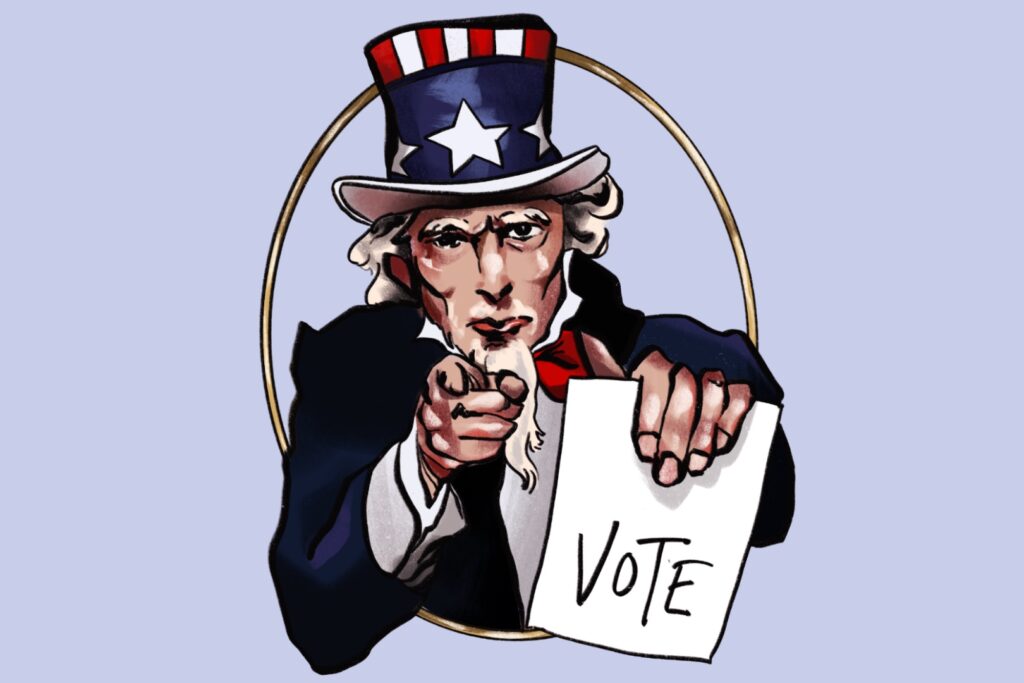
SUNN Post Exclusive
Why do there always seem to be many one-star and five-star product reviews online, but fewer in between?
This “Self-selection Bias” is familiar to researchers.
The logic goes that, because it’s mainly the most motivated who bother voicing their opinions, voluntary surveys disproportionately record the most extreme views. The indifferent consumers stay silent, even if they somewhat enjoy or are disappointed in a product.
About an Amazon listing, it may not matter — but just as voluntary comment threads often fail to grasp the true opinions of the public, our presidential elections similarly fail, instead reflecting only the voices of the most passionate, not the majority.
In the most recent 2024 election, voter turnout was 64%. Worse, only 3 in 4 eligible voters were even registered. Somewhere down the line, low voter turnout has been normalized to an extent where it feels inevitable. But it is truly astounding to think that we accept an election that represents the “majority” when 36% of eligible Americans are not accounted for, especially when we consider most presidential elections have relatively slim margins that could easily be overturned by this silent proportion of people.
It doesn’t have to be this way. The most recent Australian election had a voter turnout of 90%, Argentina’s was 76%, and Brazil’s, 79%. The difference may be as simple as this: in these countries, voting is compulsory.
Compulsory voting “forces” all eligible citizens to vote by creating a disincentive for not voting. These are often modest penalties, but effective ones in changing the culture. In Australia, for example, all citizens who don’t vote are fined 20 Australian dollars, which is about 13 US dollars.
Compulsory voting is more than just another way to do things. It’s especially appealing now given how much social media influences politics, mobilizing those extremes in warped ways. Half of U.S. adults use social media to follow the news, but two-thirds believe social media is harmful for democracy. Coupled with algorithm-driven content filtering, the result is that those who are politically interested are surrounded in an echo chamber of content that encourages political cynicism, anger and misinformation.
This kind of political polarization is concerning, given how it increases the likelihood that voters will support an anti-democratic candidate, parties are less likely to cooperate and there is an increased likelihood of gridlock as centrists refuse to pass extreme legislation proposed by polarized politicians.
Political polarization also increases alienation, turning assumptions about political groups into realities. You’ve probably heard a friend or family member state they simply won’t vote because both parties are incompatible with their beliefs. In a self-reinforcing cycle, the politicians who the vocal voters elect are in fact full of irreconcilable differences. The phenomenon isn’t entirely unique to now. In fact, in polling after the 1980s US presidential elections, American National Elections Studies data found that a whopping 1 in 5 eligible voters abstained due to feelings of alienation from the parties.
By contrast, forcing this quiet proportion of the electorate to vote shifts power away from the extreme voters and incentivizes politicians to align themselves with more centrist politics — which is less likely to bring about strong support, but is also less likely to bring about strong opposition. Stalemates heal, policies at least pass — even if they aren’t the most ideal — and a great deal of the biases we’ve developed about politics start to look outdated.
Of course, to propose that we punish those who don’t vote, we must be sure that voting is truly accessible to all. Currently, elections are on Tuesdays, a weekday, and not everyone is given paid time off to vote. Paired with compulsory voting, a viable solution would be to move elections to weekends, like Australia does, or make election day a federal holiday.
We seem to be going in the other direction. Mail-in voting is harder than ever, as is registering. Republicans are largely leading the charge. Critics contend that they stand to gain the most from increased absenteeism — a point Republicans have even voiced publicly — but recent data challenges that assumption in the social media age and characterizes the country’s abstaining voters as more split down the middle than previously thought.
In a democracy, encouraging eligible voters to vote — and making sure they can make it to their polling locations with viable mail-in options — should be a bipartisan issue.
While compulsory voting may seem to violate individual liberty, it’s important to note that civic duties like paying taxes or serving on juries are also mandatory, and voting is just as essential to a functioning democracy if not more so.
In a time when polarization, misinformation, and disengagement threaten the integrity of our elections, making voting not just a right but a shared responsibility may be the key to ensuring that every voice — not just the loudest — is heard loud and clear. Until then, we should avoid making sweeping statements about what American voters do or don’t want. The simple truth is that we don’t know.
